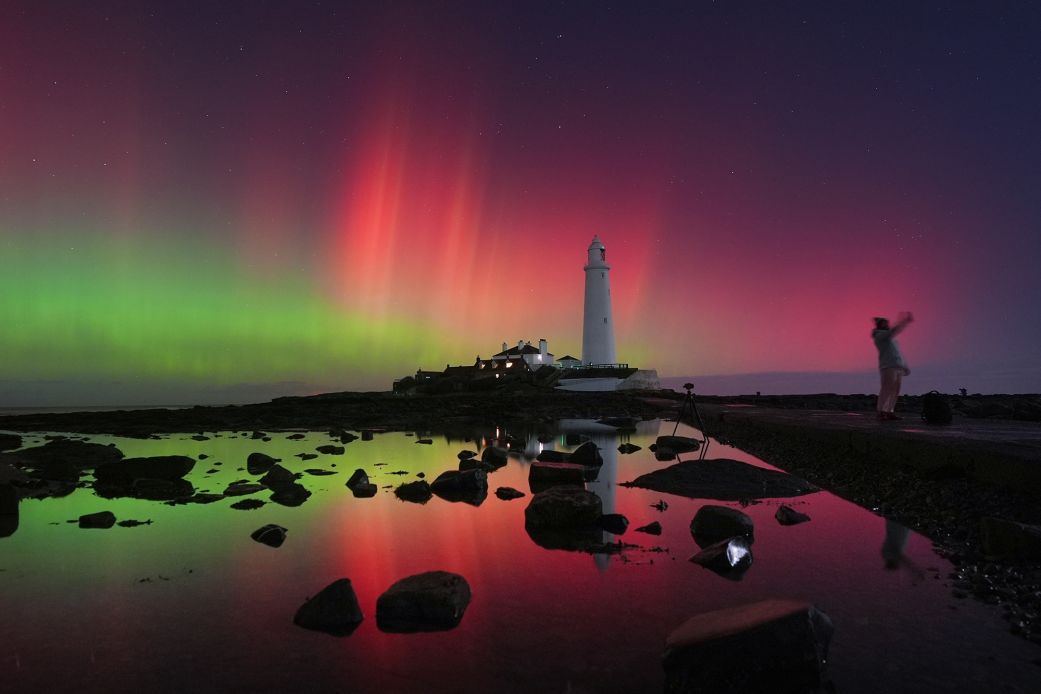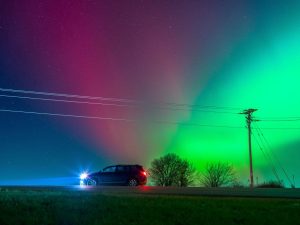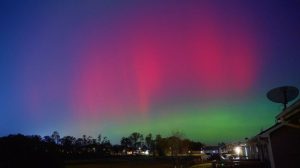Key Takeaways
- Rare auroras seen as far south as Florida due to intense solar storms
- G3 geomagnetic storm ongoing, could escalate to severe G4 levels
- Third solar storm arriving Wednesday, promising more auroral displays
- NASA’s Mars mission launch postponed due to space weather
Dazzling auroras lit up skies across the United States on Tuesday night, with rare sightings reported from Florida to West Virginia. The spectacular light show resulted from powerful solar storms hitting Earth’s atmosphere, with forecasters predicting another round of colorful displays on Wednesday evening.
The National Weather Service’s Space Weather Prediction Center reports ongoing strong geomagnetic storm conditions, currently classified as G3 on a 1-5 severity scale. The event could intensify to severe G4 levels, with northern US states likely to witness auroras again on Thursday.
What is a ‘Cannibal Storm’?
British Geological Survey experts have dubbed this event a “cannibal storm” – where two coronal mass ejections (CMEs) merged before reaching Earth. “The first one was moving more slowly than the second,” explained the survey’s geomagnetism team, “so the second one caught up with the first one and they amalgamated together by the time they reached Earth.”
“Our data suggests that this event could be one of the biggest storms we’ve seen in 20 years,” said Dr. Gemma Richardson, hazard specialist at the British Geological Survey.
The British Geological Survey warns the current solar activity could potentially escalate to G5 – the highest level of geomagnetic storm.
Real-World Impacts
Beyond creating beautiful auroras, these geomagnetic storms can disrupt communications, power grids, and satellite operations. The effects have already been felt in space missions, with postponing the launch of its Escapade Mars mission aboard Blue Origin’s New Glenn rocket.
“NG-2 Update: New Glenn is ready to launch. However, due to highly elevated solar activity and its potential effects on the ESCAPADE spacecraft, NASA is postponing launch until space weather conditions improve. We are currently assessing opportunities to establish our next launch,” according to a post by Blue Origin on social media platform X.
Tuesday’s solar activity created the largest measured geoelectric field since records began in 2012, reaching 3.5 volts per kilometer in Scotland’s Shetland Islands – an unprecedented measurement that can interfere with electrical transformers.
Solar Activity Peaks
The current outburst stems from sunspot region AR 14274, which has released three X-class solar flares this week – the most intense category. While this region is now rotating away from Earth, experts caution that the strongest solar flares typically occur during the decay phase of the solar cycle.
“AR 14274 still has the potential to produce more X-class solar flares,” said Ryan French, solar physicist at the University of Colorado Boulder. “However, the region is now rotating away from us, so any eruptions from future flares are increasingly less likely to hit us as the days pass.”
Viewing Opportunities
The third solar storm is expected to reach Earth Wednesday afternoon, potentially creating auroras visible across much of the United States this evening. Even if not visible to the naked eye, camera sensors and smartphone cameras may detect the colorful displays.
Sky-gazers in Scotland, northern England, and Northern Ireland also have good chances of witnessing the auroras, according to the British Geological Survey.
This event ranks as the third strongest solar storm of the current solar cycle, though it remains less intense than the historic Carrington Event of 1859 or the May 2024 G5 storm that affected GPS systems for precision farming.







